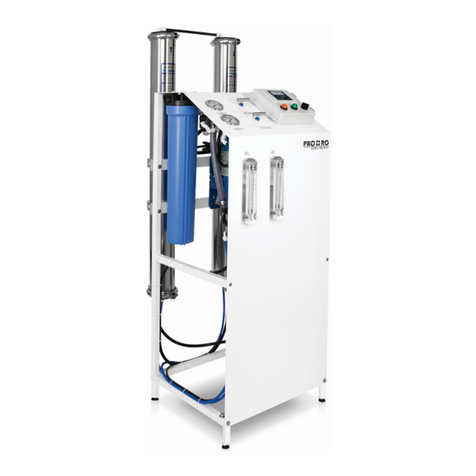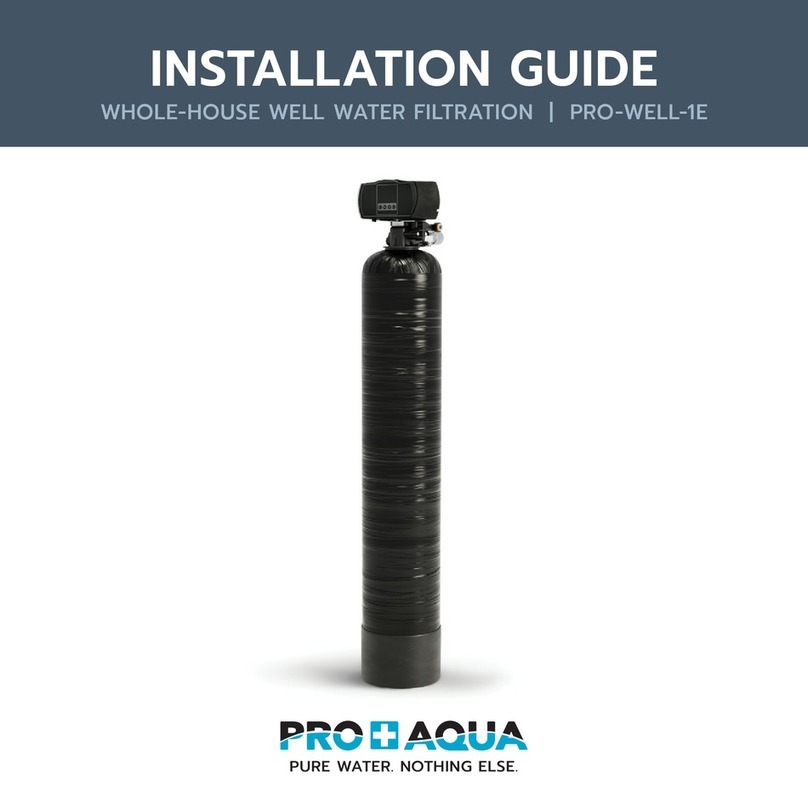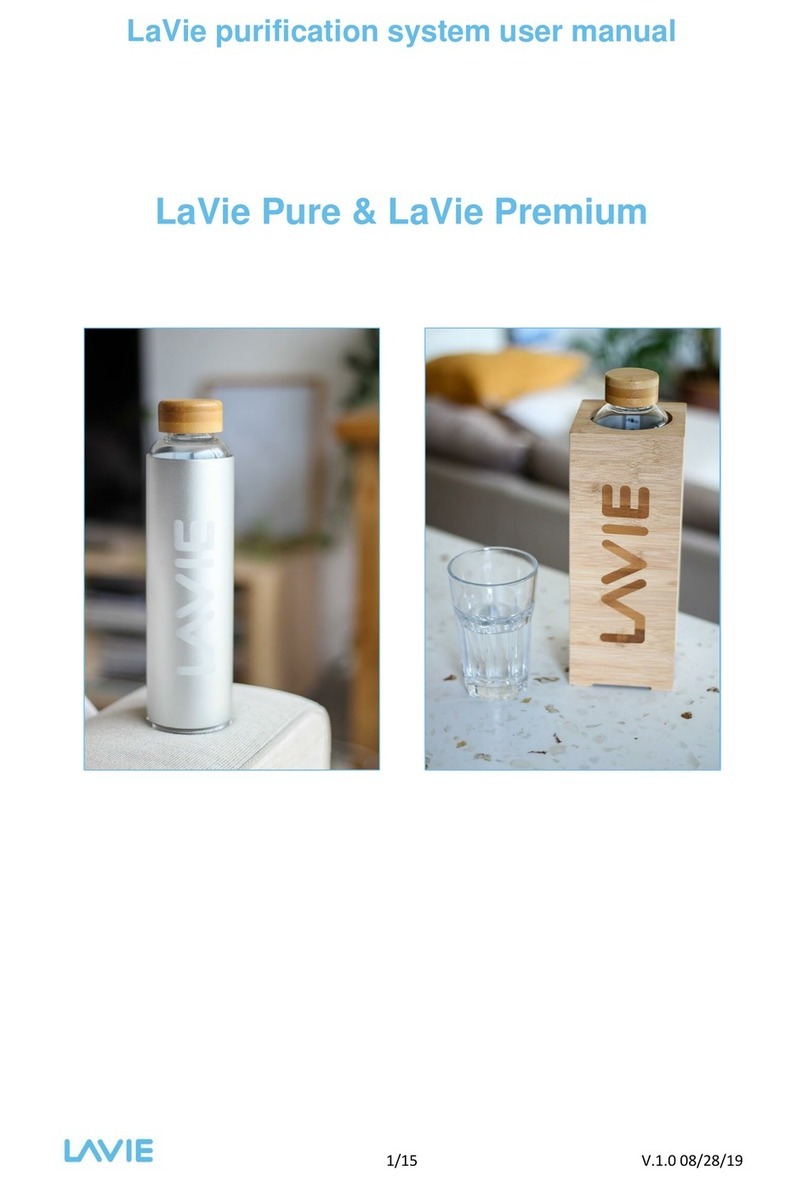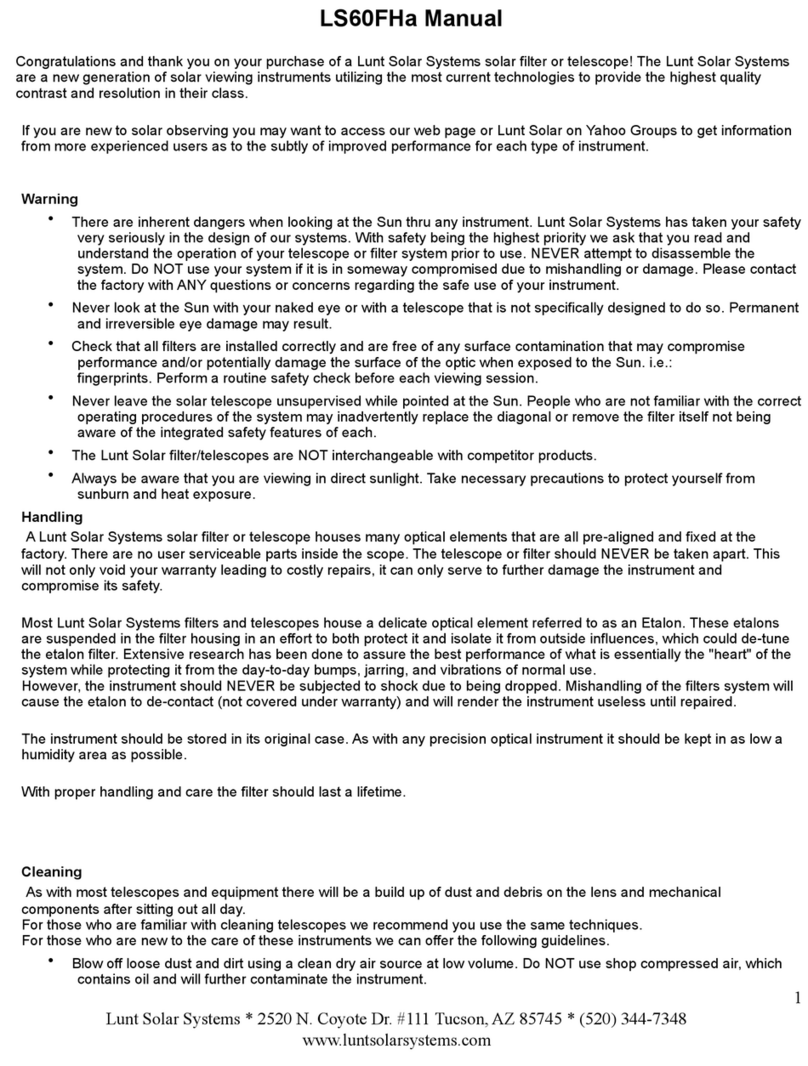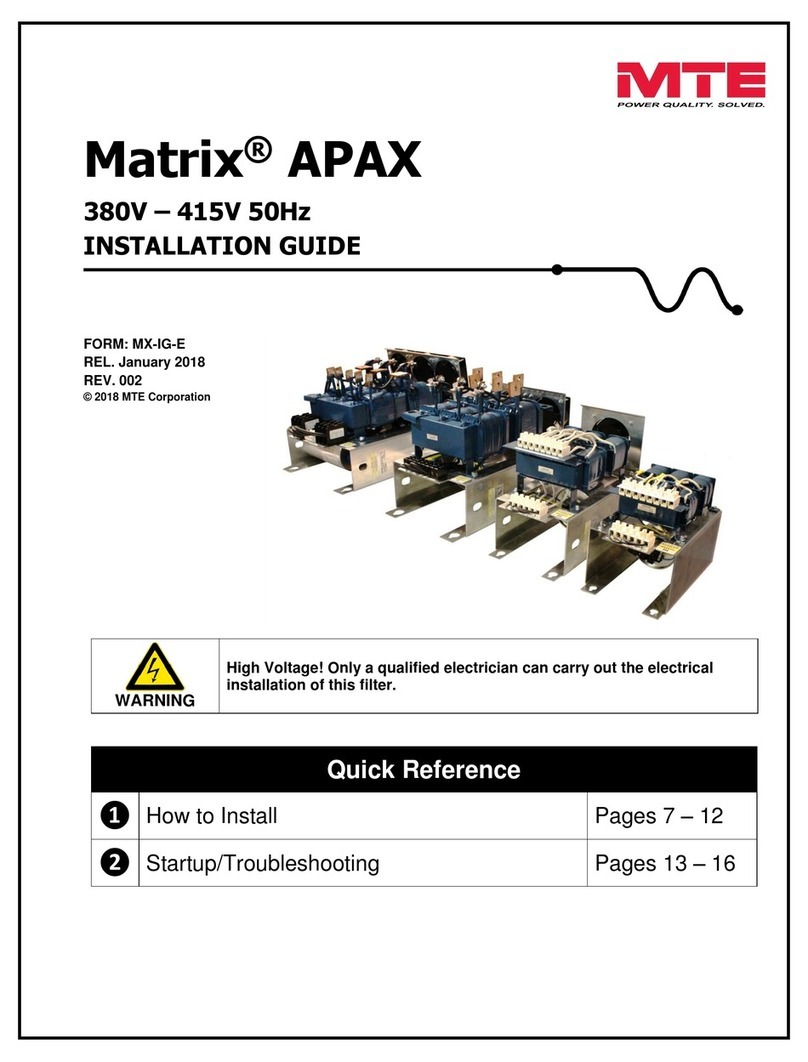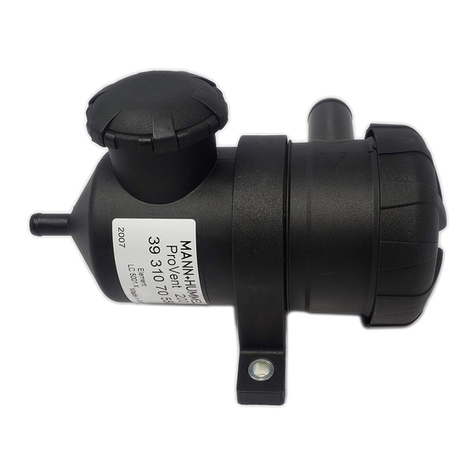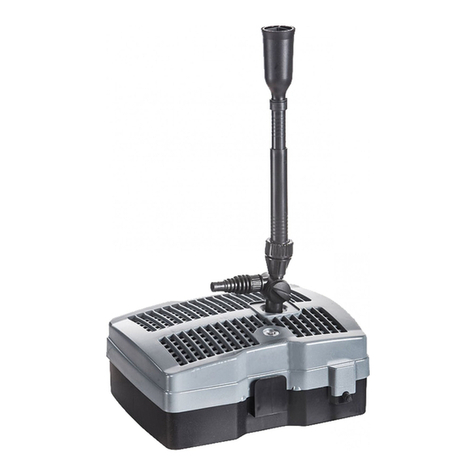Pro-Aqua PRO-UC-ROSTD User manual

www.proaquawater.com.com
PRO-UC-ROSTD | Reverse Osmosis
Drinking Water System
Professional Water Filtration Systems


TABLE OF CONTENT
MKT100P 0422-01/v.01/2022
SECTION PAGE
WELCOME & CONGRATULATIONS...........................................................1
EXTENDED WARRANTY ............................................................................... 2
INSPECTION & PREPARATION................................................................. 3
COMPONENTS AND TOOLS IDENTIFICATION ................................. 4
PREINSTALLATION .................................................................................... 5
System Location.................................................................................... 5
Site Preparation..................................................................................... 5
Unit Preparation .................................................................................... 5
INSTALLATION INSTRUCTIONS.............................................................. 6
Faucet Installation ................................................................................ 6
Feedwater Adapter Installation......................................................... 7
Drain Saddle Installation..................................................................... 9
Initial Tubing Connections.................................................................. 9
RO Component Installation .............................................................. 9
RO Unit Installation ............................................................................ 10
Pre-fill Storage Tank and Placement ............................................. 10
Final Tubing Connections ................................................................ 10
SYSTEM STARTUP ..................................................................................... 11
Pre-Start Instructions ........................................................................... 11
Flushing and Operation Check ....................................................... 11
MAINTENANCE ........................................................................................... 12
Sanitizing Instructions ....................................................................... 12
Water Quality ....................................................................................... 13
Water Production ................................................................................ 14
Water Pressure and Temperature ................................................. 14
FITTINGS INSTALLATION INSTRUCTIONS ........................................ 15
Quick Connect Fittings ..................................................................... 15
Conventional Compression Fittings .............................................. 15
FLOW CHART & SPARE PARTS .............................................................. 16
FILTER REPLACEMENT INSTRUCTIONS ............................................. 17
WARNINGS ................................................................................................... 18
SUBSCRIBE AND SAVE ............................................................................ 19
INSTALLATION NOTES............................................................................. 20

- 1 -
Thank you for choosing Pro+Aqua. This owner’s manual will guide you through the necessary steps to
fully self-install the Reverse Osmosis Drinking Water System.
Please read this manual carefully before installation and use.
The information listed in this manual covers the steps for a self-serve installation. In the event that you
need support, our Pro+Aqua technicians are available to answer any questions during our regular busi-
ness hours.
Hours of Operation: M-F 9:00AM - 5:00PM PST
Telephone: 1800-980-3335
Email: hi@proaquawater.com
WELCOME & CONGRATULATIONS

- 2 -
Don’t miss out on four (4) free years of additional system coverage.
Register your product within 60 Days from time of purchase to add four years of protection
covered under our Pro+Aqua Warranty.
1. Locate the serial number on your bracket.
2. Visit proaquawater.com/warrantyregistration
3. Enter your purchase and serial number information.
No time to go online?
Let our Pro+Aqua Certied Tech Team do the work for you. Simply follow the steps below and in 2-3 working
days we’ll send you conrmation of your product being registered.
Where is your serial
number located?
Purchaser Name: ______________________________________________________________
Email: ___________________________________________________________________________
Phone: __________________________________________________________________________
Address: ________________________________________________________________________
__________________________________________________________________________________
City: ____________________________________________________________________________
State: ___________________________________________________________________________
Zip:______________________________________________________________________________
Order Number:_________________________________________________________________
Order Date: ____________________________________________________________________
Serial Number: _________________________________________________________________
Place of Order: _________________________________________________________________
1. Fill out the form by handwriting
your info.
2. Take a picture of the form with
your device.
3. Scan the QR code with your
device camera and click the
banner that appears.
4. Attach the picture of the form to
the email that opens.
5. Hit Send and you’re DONE!
The serial number could be
found on the back of the
system bracket.
Registration with your mobile
device is easy.

- 3 -
INSPECTION & PREPARATION
Get familiar with these steps before installing.
WARNING: DO NOT USE WITH WATER THAT IS MICROBIOLOGICALLY UNSAFE OR OF UNKNOWN QUALITY
WITHOUT ADEQUATE DISINFECTION BEFORE OR AFTER THE SYSTEM.
!
CHECK WITH YOUR STATE AND/OR LOCAL PUBLIC WORKS DEPARTMENT FOR PLUMBING CODES.
!
FAILURE TO FOLLOW THIS GUIDE COULD CAUSE SYSTEM FAILURE OR PROPERTY DAMAGE.
!
NOTE:
Failure to comply with these installation instructions will void the product Warranty, and the
installer will be esponsible for any service, repair or damages caused thereby.
?

- 4 -
COMPONENTS AND TOOLS IDENTIFICATION
Your Reverse Osmosis System has been tested to ensure it will operate correctly. The following periodic
maintenance is recommended so your system will provide years of trouble-free service:
Replacement part Frequency
Pre-filter (sediment) Every 6 mos.
Pre-filters (activated carbon) Every 6 mos.
R/O membrane Every 1-2 years
Post filter (carbon) Every 6 mos.
Components
The following components make up your Reverse Osmosis Drinking Water System:
Pre-filter (sediment) removes larger particles such as sand, silt, rust and scale.
Pre-filters (activated carbon) remove chlorine in the feed water to protect the reverse osmosis
membrane.
Reverse Osmosis Membrane reduces dissolved minerals, metals and salts. During the pro-
cess, harmful compounds are separated by the membrane and the reject water goes to waste
(drain).
An activated carbon post-filter is provided for a final “polish” and to remove foul tastes, odors
and to provide great tasting drinking water.
Filter housings and RO module hold pre-filters and membranes. A bracket is provided so they
may be mounted, typically below sink.
Storage tank holds filtered water, ready for use.
Automatic shut-o valve senses when the storage tank is full and closes the water supply to
conserve water.
The dedicated faucet is used to dispense RO produced water when needed.
Feed water valve is connected to the cold water line to supply water to the R/O system.
Waste water saddle valve is connected to the drain to remove reject water from the R/O
system.
Tubing supplies feed, reject water, and clean water.
Fittings are used for necessary hose connections
• 3/8” variable speed electric drill, 1/8” &
1/2” bits
• 1-1/4” porcelain hole cutter (if hole for
second
• Faucet is not provided
• Center punch and hammer
• 1-1/4” wood bit
• Concrete drill bits
• Phillips head and flat blade
screwdrivers
• Adjustable wrench
• Crescent wrench
• Teflon tape
• Plastic tube cutter
• Air pressure gauge (low pressure)
• Air pump (hand)
Tools
The following tools may be necessary, depending on your installation:

- 5 -
PREINSTALLATION
System Location
Your R/O system may be installed under a sink, in a basement or other location, depending on
available space. Do not install unit where temperatures fall below freezing; otherwise, damage will
result. Connection to an icemaker should also be considered for optimum performance.
Guidelines for component placement are as follows:
Faucet should be placed near the sink where drinking/cooking water is normally required.
A 2” flat surface is required to mount the faucet if an existing hole for a second faucet is not
available. The diameter of the hole should not exceed 1-1/4”.
Storage tank may be placed where it is convenient, within ten feet of the faucet. Under the
sink or in a nearby cabinet are excellent choices. If tank is located further than 10 feet from
the faucet, use 1/2” tubing to reduce pressure drop. Full tanks may weigh more than thirty
pounds, so a sturdy shelf is required.
R/O unit may be mounted on either side of the sink, in a cabinet or heated basement, with
nearby access to a potable, cold water line.
Feed water connection is accomplished with a feed water valve. Locate this assembly as
close to the R/O unit as possible. Connect to a potable, cold water supply line only.
Note: Softened water is preferred since it will extend the life of your R/O membrane.
Drain connection is accomplished using a waste water saddle valve which is designed to fit
around a standard 1-1/2” OD drain pipe. The drain saddle valve should always be installed
above (before) the tap and on the vertical or horizontal tailpiece.
Do not install the drain saddle valve near a garbage disposal; otherwise, plugging of the
waste water line may occur. If discharging into a utility sink or standpipe, an air gap must be
provided. (Air gaps must be 1” or greater above the floor rim.)
Do not connect the R/O system drain line to the dishwasher drain line as back pressures
may cause the air gap to overflow.
Site Preparation
Installing dealers may want to speak with customers in advance and ask them to clean under the
sink to save time. If a basement installation is advisable, check area to determine if extra fittings
or hosing are required. Upon arrival, it is a good idea to check the condition of all plumbing for
potential leaks and advise customer so there will be no misunderstandings in the event leaks
occur.
Unit Preparation
Open shipping carton, remove components and check that all parts are present. Check empty storage
tank to be sure air pressure is approximately 7 PSI.
NOTE:
Plumbing codes may require the diameter of the hole. Please check with your
local municipality.
?
NOTE:
Adjust if necessary.
?

- 6 -
INSTALLATION INSTRUCTIONS
Faucet Installation
If the sink has a sprayer it may be disconnected for faucet installation. (Installing dealers should dis-
cuss this with customers.) A pipe cap or plug will be necessary to seal the sprayer connection.
To make the faucet mounting hole (if sprayer or second hole is not used), check below to make sure
the drill does not interfere with anything below. Center punch a small indent at the desired faucet
location. (2” flat surface is required, not exceeding the chassis punch and tighten nut to cut the de-
sired hole size. Clean up sharp edges.
The faucet should be positioned so it empties into the sink and the spout swivels freely for conve-
nience. If sink has a hole that can accommodate the RO faucet, no drilling is required.
Proceed with mounting the faucet.
1
Procedures
1. Mark the center for the 7/8” hole.
2. Form shallow putty around hole area and fill with enough water to lubricate carbide drill
bit.
3. Carefully drill pilot hole through all layers. (Use light pressure and slow speed.)
4. Insert pilot tip of spring-loaded porcelain cutter into pilot hole.
5. Drill porcelain/enamel using spring loaded porcelain cutter, making certain a complete ring
has been cut through the porcelain / enamel to the metal base.
6. Cut away the inner porcelain / enamel disc down to the base metal. Make certain the
cutter does not touch outer rim of the cut porcelain / enamel. Continue with his bit to cut
through metal until sink has been completely penetrated.
PORCELAIN, ENAMEL, CERAMIC ON METAL OR CAST IRON PRECAUTIONS MUST BE TAKEN
TO PENETRATE THE PORCELAIN THROUGH TO THE METAL BASE AND PREVENT IT FROM
CHIPPING OR SCRATCHING.
!
Tools required:
• Variable speed drill
• Relton porcelain cutter tool set (7/8” or alternative size, 9/16”)
• Plumber’s putty
NOTE:
All plumbing must be completed in accordance with state and local plumbing codes.
Some municipalities may require installation by a licensed plumber. Check local authority
prior to installation.
?
NOTE:
Always use sharpened porcelain cutter to eliminate chips and cracks.
?

- 7 -
Mounting the Faucet
Disassemble hardware from the threaded nipple, except for chrome base plates and rubber washers.
(Rubber washers may be replaced with bead of plumber’s putty for neater appearance.)
Feed the threaded nipple through sink or counter mounting hole and orient the faucet. From below
sink or counter, assemble the white spacer flat washer and hex nut on threaded nipple and tighten
by hand. (Open end up; open side toward air gap). After checking faucet orientation, tighten with a
wrench until secure.
2. Some shut o valves have an extra port for an icemaker hookup. You will not need the
feedwater adapter for this type of installation. (See diagram A )
3. On some shut o valves you can install the feedwater adapter directly to the valve.
Slip the black washer into the feedwater adapter. Tighten feedwater adapter to the valve
with an adjustable wrench. Tighten until snug. Insert the 1/4” metal ball valve into the
feedwater adapter.
1. Turn o cold water supply to the sink using the supply valve located under the sink.
STAR LOCK WASHER
SHANK
BLACK PLASTIC WASHER
CHROME NUT
SMALL
BLACK GASKET
CHROME WASHER
RUBBER GASKET
PLASTIC SLEEVE
COMPRESSION NUT
TUBE
1/4” TUBE INSERT
Installation Procedures for Stainless Steel Sinks
Recommended tools:
• Center punch
• Variable speed drill
• High speed drill bits
• Greenlee chassis punch 7/8” (or 9/16” for non air gap faucets)
• Protective gloves & eye protectors
Procedures
1. Center punch small indent for hole.
2. Drill the required pilot hole.
3. Set-up the chassis punch per instructions and tighten nut
to cut the desired hole size.
4. Clean up sharp edges with file.
Feedwater Adapter Installation
2
CAUTION!! For your safety and protection, do not use where water is microbiologically unsafe
or of unknown quality. The water supply to your system MUST be from the COLD WATER LINE!
Hot water will severely damage your reverse osmosis system!
!
DO NOT OVERTIGHTEN! (See diagram B )
!
NOTE:
In some cases the supply valve may leak or may not work at all. If this happens
turn o the water at the main water shut o for the entire house. In extreme cases
the house shut o valve does not work. If this happens shut the water o at the
street and replace the defective valves immediately. Locate the type of shut o
valve you have under your sink and follow that step for connecting the feedwater.
?

- 8 -
Most under sink shut o valves have a built in smooth or corrugated riser going up to the
faucet. (Refer to Diagram C for help with this type of valve.) Secure an adjustable wrench
to the fitting on the cold water side of the sink faucet -- NOT THE R.O. Faucet! Secure
another adjustable wrench to the smooth/corrugated riser line nut. Gently undo the riser line
from the sink faucet. Do not be alarmed! There will be water left in the line—this is normal.
However, if the flow does not stop you probably haven’t shut the water o properly.
4. Insert the black rubber washer into the feedwater adapter. Screw the adapter onto the fitting
coming from the cold water side of the sink faucet. Tighten the feedwater adapter to the
cold water line. Take extreme care not to twist or damage the connection to the cold water
connection.
5. Connect the riser from the water shut o valve to the feedwater adapter. Ensure that the
cone washer on the riser tube is in good condition. Connect the riser to the feedwater
adapter.
6. If your line port is 1/2 inch use the included fittings (Diagram B).
7. If your line ports are 3/8 inch remove the fittings from the feedwater adapter (Diagram C).
CAUTION!! Tightening the connector improperly to the sink faucet could cause
irreparable damage to the faucet.
!
DO NOT OVERTIGHTEN! This can cause damage to the riser connection or
feedwater adapter.
!
DO NOT OVERTIGHTEN!
!
Cold Water
Line
TURN OFF
WATER FIRST!
1/2 Inch
Connection
3/8 Inch
Connection
Blue Tubing
Cold Water
Line
TURN OFF
WATER FIRST!
Insure the O-rings
are inside the
connectors
Rotate counter-clockwise
to tighten Insure the O-ring
isinside the
connectors
DIAGRAM A
Cold Water
Line
TURN OFF
WATER FIRST!
1/2 Inch
Connection
3/8 Inch
Connection
Blue Tubing
Cold Water
Line
TURN OFF
WATER FIRST!
Insure the O-rings
are inside the
connectors
Rotate counter-clockwise
to tighten
Insure the O-ring
isinside the
connectors
DIAGRAM B
Cold Water
Line
TURN OFF
WATER FIRST!
1/2 Inch
Connection
3/8 Inch
Connection
Blue Tubing
Cold Water
Line
TURN OFF
WATER FIRST!
Insure the O-rings
are inside the
connectors
Rotate counter-clockwise
to tighten
Insure the O-ring
isinside the
connectors
DIAGRAM C

- 9 -
Drain Saddle Valve Installation
Prior to proceeding it is important to inspect the condition of drain pipes to make sure they are not
thin and frail.
Drain saddle valves are designed to be installed on standard 1-1/2” OD drain pipe. Install drain saddle
valve above (and before) the trap and on the vertical or horizontal tailpiece. Never install a drain sad-
dle valve close to the outlet of a garbage disposal or plugging of the RO drain line may result.
Procedures
1. Position threaded half of drain saddle valve at selected location and mark for the opening.
2. Drill 1/4” hole at mark through one side of pipe.
3. Position both halves of drain saddle on drain pipe so threaded opening lines with hole.
4. Secure drain saddle clamp on valve with bolts and nuts provided. (Do not over tighten and
make sure there is equal space between saddle halves on each side.)
3
Initial Tubing Connections
For convenience on under counter installations it may be advisable to complete under counter hose
connections at this time. (Fittings Installation Instructions on page 10)
4
RO Component Installation
Install RO membrane, carbon pre-filter and sediment pre-filter in modules of RO unit. (Refer to RO
installation diagram.)
5
1/4" Screw 1/4" Nut
Drain pipe
1/4" Drilled hole
Drain clamp
front plate
Drain saddle valve installation (brass insert)

- 10 -
RO Unit Installation
The RO unit is normally mounted to the right or left sink cabinet sidewall, depending on where supply
tank is to be located. Generally the unit is installed at the front of the cabinet and the tank at the rear.
To mount the unit, elevate it at least 2” o the floor, level it and mark the location of mounting holes
needed. Drill holes for mounting screws and install screws, allowing the mounting bracket slots to
slip over them.
6
Pre-fill Storage Tank and Placement
Pre-filling the storage tank is always recommended so there is sucient pressure to check for leaks
and sucient water to flush the carbon post filter.
It is important to use a sanitizer (such as Clorox) so tubing, fittings, tank and the faucet will be safe to
use upon start-up.
7
Final Tubing Connections
With all components in place, complete nal tubing connections using these guidelines:
• Tubing should follow contour of the cabinets.
• Cut tubing to desired length using square cuts
• and proper cutting devise.
• Make no sharp bends.
Keep tubing from the RO unit to the tank and faucet as short as practical for good flow.
Under sink installations following installation diagram and the following procedures:
1. Connect tubing from faucet to RO unit.
2. Connect tubing from tank to RO unit.
3. Connect tubing from supply valve to RO unit.
4. Connect tubing from drain valve to RO unit. (For Fittings Installation Instructions go
to page 9)
8
To pre-fill storage tank follow these directions:
1. Connect storage tank to feed water line.
2. Open feed water valve and valve on tank.
3. Allow to fill for approximately three minutes.
4. Turn o feed water valve and tank valve.
5. Do not flush tank for approximately 15 minutes.
The supply tank should be placed under the counter
or within 10 feet of the RO unit.
NOTE:
Tanks are pre-pressurized at 7 psi. Prior to installation, check, add or release
as required.
?
NOTE:
If the cabinet sidewalls are not solid, unit may sit on the floor with screws to keep it against
the cabinet in a vertical position.
?

- 11 -
1. Check all connections to be sure they are secure.
2. Turn on feed water valve and check for leaks.
(Turn o and correct leaks if leaks occur.)
3. Open valve on storage tank and open faucet until a steady stream of water flows.
4. Close faucet and wait five minutes to see if leaks result.
1. Open faucet handle and allow tank to completely drain of sanitizing solution.
2. With faucet handle in “open” position, measure the rate of the steady drip from spout. Use
a graduated cylinder and watch with a second hand to calculate approximate production
in gallons per day.
3. Proceed to check reject flow rate by disconnecting tubing at drain connection and mea-
sure flow as described above.
Icemaker Hookup (optional)
The RO drinking water device can be connected to any standard refrigerator ice maker or ice maker/
water dispenser. (Do not connect to a commercial type bar ice maker.)
To complete this operation, connect a tee with shuto valve into the faucet tubing and route tubing
to the refrigerator. (Hooking up to an existing copper line is not recommended unless it is new
installation.) Shut o ice maker by lifting lever prior to turning o the existing tap water supply line to
the refrigerator. Turn on ice maker after the RO system has been drained several times and the tank
has a full supply of water.
SYSTEM STARTUP
Pre-Start Instructions
Flushing and Operation Check
To make sure RO system is operating correctly, following these simple procedures:Turn on feed
water valve and check for leaks. (Turn o and correct leaks if leaks occur.)
NOTE:
When tank is empty, faucet will steadily drip. This is the rate the RO system
processes water.
?
NOTE:
Milliliters per minute x 0.38 = GPD Ounces per minute x 11.2 = GPD
?
NOTE:
Proper ratio should be 3 reject water to 1 part of product water, on average.
?
NOTE:
When the system is first turned on, water may intermittently “spurt” from the air gap
opening on the side of air gap faucets. This is common and should correct itself
after an initial period of time.
?
NOTE:
Before any service is preformed on the RO system, turn o ice maker valve and ice
maker unit. Turn back only after RO tank is full.
?
DO NOT USE THIS WATER!
!

- 12 -
4. Close faucet and re-inspect system for leaks.
5. Allow system to process water for approximately four hours, at which point tank will be
practically full.
6. Open faucet again and allow tank to empty for a second time.
7. Wait another four hours to allow tank to re-fill.
DO NOT USE THIS WATER!
!
NOTE:
If no objectionable tastes are noticed after second tank draining, RO processed
water is ready for use. Otherwise, drain tank and re-fill for a third time.
?
NOTE:
If no objectionable tastes are noticed after second tank draining, RO processed water is
ready for use. Otherwise, drain tank and re-fill for a third time.
?
NOTE:
Be sure to check o-rings are in place when installing cartridges in filter housings.
?
8. At this point supply line to ice maker connection (optional) may be opened.
MAINTENANCE
Your RO system contains filters and membranes which must be replaced periodically for proper
operation. (Please see page 1 for general changeout recommendations.)
To change filters and membranes follow these procedures:
1. Close feed water valve by turning it clockwise.
2. Open faucet to allow holding tank to drain.
3. Loosen and remove filter housings using wrench provided and discard cartridges and or
membrane.
4. Wash the inside of the housings using mild detergent and soft cloth.
Thoroughly rinse all soap before reassembly.
5. Replace filter cartridges and membrane before sanitizing system.
Sanitizing Instructions
To sanitize system follow these procedures with the feed water valve closed:
1. Remove pre-filters and membrane from housings.
2. Use 5-1/4% unscented bleach such as Clorox.
3. Add one cap full (2 tsp or 10 ml) of bleach to each pre-filter housing and membrane mod-
ule.
4. Carefully re-fill housings with tap water and temporarily replace without carbon cartridge,
sediment cartridge or membrane installed.

- 13 -
DO NOT USE THIS WATER!
!
Water Quality
Water quality from an RO system is normally determined with a TDS Meter, which measures total
dissolved solids in water, measuring conductivity. The results are normally measured in parts per million
or milligrams per liter. Fewer dissolved solids results in higher quality water.
RO membranes are rated by the amount of dissolved solids they reject expressed as “rejection
percentage”.
For example:
If feed water contains 100 ppm of dissolved solids and the product water after the membrane has 10
ppm of dissolved solids the rejection rate is 90%.
5. Slowly open the feed water line at faucet.
6. Close faucet as soon as water begins to
drip out of spout.
7. Let system stand for approximately 15 minutes.
8. After fifteen minutes do the following in order:
• Close feed water valve.
• Close holding tank valve while faucet is open to release pressure.
9. Remove housings and empty them.
10.Remove any protective wrap from pre-filters and membrane and install them in the appro-
priate filter housings. Tighten with wrench.
11. Replace post carbon filter if necessary.
12.Disconnect product water tubing from the holding tank and put 50 drops of bleach into
the tubing. Reconnect tubing.
13.Slowly open feed water saddle valve. When water begins to drip from faucet, close faucet
and open holding tank valve.
14.Do not open faucet for at least eight (8) hours.
15.Discard the first two tanks of water produced, as they contain chlorine.
16.When faucet is first opened, air and black carbon powder may be noticed. This is normal.
The formula is as follows:
Percent
Rejection =
(Feed H2O TDS - Product H2O TDS) x
100%
Feed H2O TDS
NOTE:
Be sure to check o-rings are in place when installing cartridges in filter housings.
?

- 14 -
Water Production
Product water rate
Usable water production from an RO system is designated product water rate, produced on a daily
basis. The rate is normally described in gallons per day (gpd) or milliliters per minute (ml/min).
Reject water rate
The flow of water to drain is designated as reject water rate, as measured in gallons per day (gpd) or
milliliters per minute (ml/min).
Water Pressure and Temperature
Product water quality and production of RO systems is dependent on pressure and temperature.
Typically, RO membranes are treated at standard conditions of 77°F (25°C) and 60 psi (4 bar)
discharging to atmosphere. In general, the higher the pressure dierential and temperature, the
greater the quality and quantity of water produced. These factors should be considered when sizing
RO systems for a particular application.
Reject ratio
The reject ratio is the amount of water produced compared to the amount of water flowing to drain.
Percent recovery
The percent recovery is another way to measure the amount of water produced compared to the
amount of water which is actually used.
The formula to determine percent recovery is as follows:
Using a graduated cylinder the formulas are:
Milliliters per minute x 0.38 = gallons per day
Ounces per minute x 11.2 = gallons per day
The formula is as follows:
Reject Ratio =Reject Rate
Product Rate
Percent
Recovery =Product H2O Rate x 100%
Feed H2O Rate
For example:
Product water rate =10 gpd
Reject water rate = 40 gpd
Feed water = (10 gpd + 40 gpd) or 50 gpd
Percent Recovery = 20%
NOTE:
Product water rate is the sum of the feed water
flow rate and reject water flow rate.
?

- 15 -
FITTINGS INSTALLATION INSTRUCTIONS
System Location
This RO systems utilize Quick Connect fittings. These user-friendly fittings provide superior
performance and may be provided with this system.
Quick Connect Fittings Installation Instructions
Cut the tubing
Cut the tube cleanly and squarely. Ensure that the tube has a smooth outside diameter without any
burrs, chamfers or score marks prior to inserting it into the fitting. Tubing that has not been cut properly
can cause drips and leaks.
1
Cut the tubing
Cut the tube cleanly and squarely. Ensure that the
tube has a smooth outside diameter without any
burrs, chamfers or score marks prior to inserting
it into the fitting. Tubing that has not been cut
properly can cause drips and leaks.
2
Inspect and test
Push and pull the tubing toward and away from the
fitting to ensure that it has been installed properly.
Test and inspect the installation for any leaks.
3
Quick Connect Fittings - Tube removal
Relieve pressure from the tubing and fitting. Push
the collet flange against the fitting body while
pulling the tubing away from the fitting to release it.
Conventional Compression fittings
If Quick Connect fittings are not used, it is essential to install inserts at the ends of all tube
connections when conventional fittings are used.
CORRECT
INCORRECT
Tubing Collet O-Ring Quick Connect Fitting
Tube Stop
Should a leak occur at a fitting, the cause is generally defective tubing. To fix a leak, relieve
pressure, release tubing, cut o at least 1/4” from the end (square cut), reattach the tubing
and confirm the connection is leak free. Each time a new connection is made, it is advisable
to cut o 1/4” from the end of the tubing using these fittings.
!

- 16 -
STAGE REVERSE OSMOSIS SYSTEMS FLOW CHART
VII. 4 STAGE REVERSE OSMOSIS SYSTEMS FLOW CHART
REPLACEMENT FILTERS
PART NUMBER DESCRIPTION QTY NEEDED
FC-10-PSD Sediment Pre-Filter 1
FC-10-ACB Carbon Block 1
FC-10-SMC High Capacity Sub-micron Carbon Block 1
TW-2012-100 RO Membrane 1
FC-I-GAC Post Carbon Filter 1
TUBING
TO TANK
SHUT-OFF
VALVE FOR
TANK
TANK
POST CARBON FILTER
TO FAUCET
AUTOMATIC
SHUT-OFF VALVE
TWO CARBON
BLOCK
PRE-FILTER
SEDIMENT
PRE-FILTER
SADDLE VALVE
FOR DRAIN
FLOW
CLIPS
CLIPS
BRACKET
RO FAUCET
FEED WATER
ADAPTER
TO COLD
WATER SUPPLY
TO DRAIN
MEMBRANE HOUSING

- 17 -
FILTER REPLACEMENT INSTRUCTIONS
1. Turn o water supply to filter.
2. Depress release button (if present) to relieve pressure in filter housing.
3. Unscrew housing using filter wrench.
4. Remove used cartridge and discard. Rinse out housing and fill about 1/3 full with water.
Add about 2 to 3 tablespoons of bleach and scrub thoroughly with brush or sponge. Rinse
thoroughly.
5. Remove O-ring/Gasket from sump and wipe groove and O-ring/Gasket clean. Lubricate
O-ring/Gasket with a coating of clean silicone grease. Place O-ring/Gasket back in place
and press O-ring down into the groove.
6. Insert a new cartridge into the sump making sure that it slips down over the
sump standpipe.
7. Screw the sump onto the cap and hand tighten. DO NOT OVER-TIGHTEN. Make sure
cartridge slips over the cap standpipe.
8. Turn on the water supply slowly to allow housing to fill with water.
9. Depress the pressure release button (if present) to release trapped air from filter.
10.Check for leaks before leaving installation.
NOTE:
When opening filter housing to change cartridge, it is common for O-ring/Gasket
to lift out of housing and stick to cap.
?
NOTE:
This step is important to ensure proper filter seal. Make sure the O-ring is seated
level in the groove (or gasket is on rim of sump)
?
If O-ring/Gasket appears damaged or crimped it should be replaced at this time.
Contact us for replacements parts.
!
Table of contents
Other Pro-Aqua Water Filtration System manuals
Popular Water Filtration System manuals by other brands
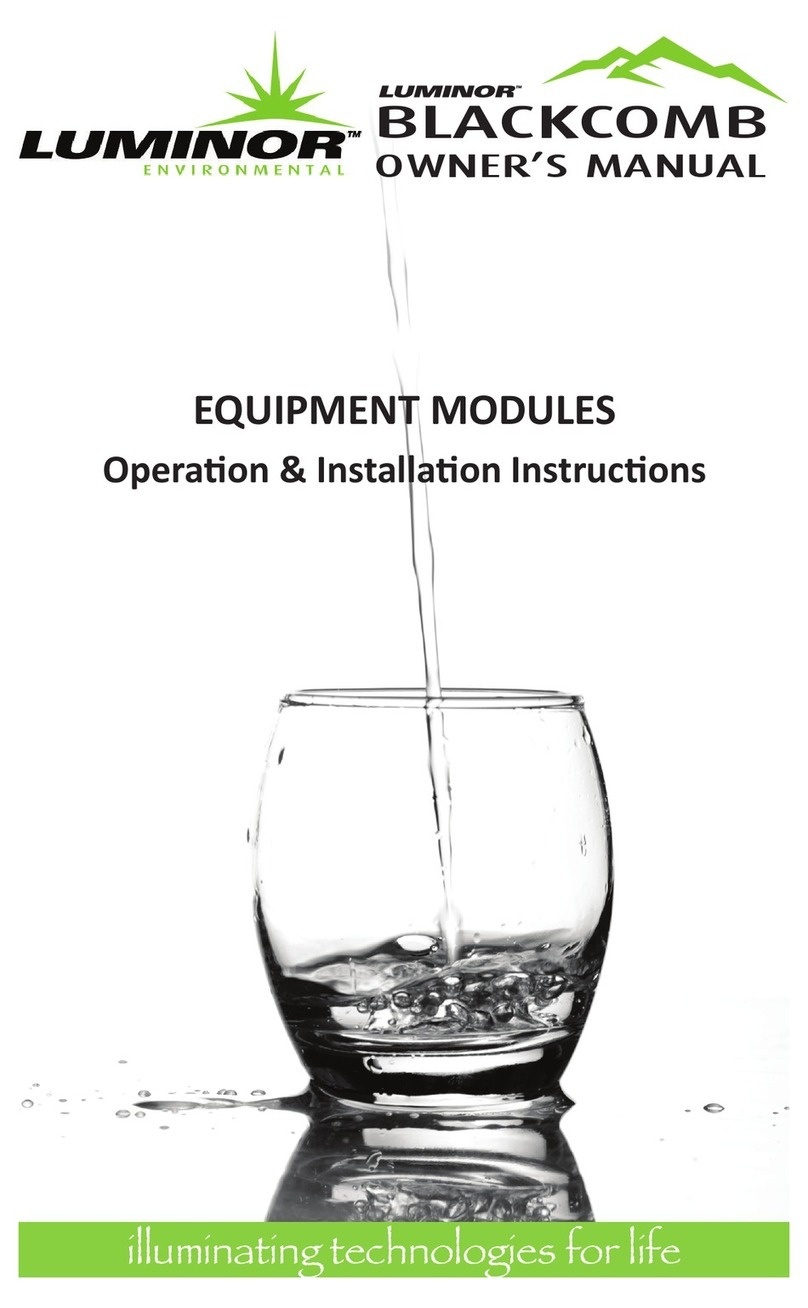
Luminor
Luminor BLACKCOMB owner's manual

Nederman
Nederman NOM 4 user manual
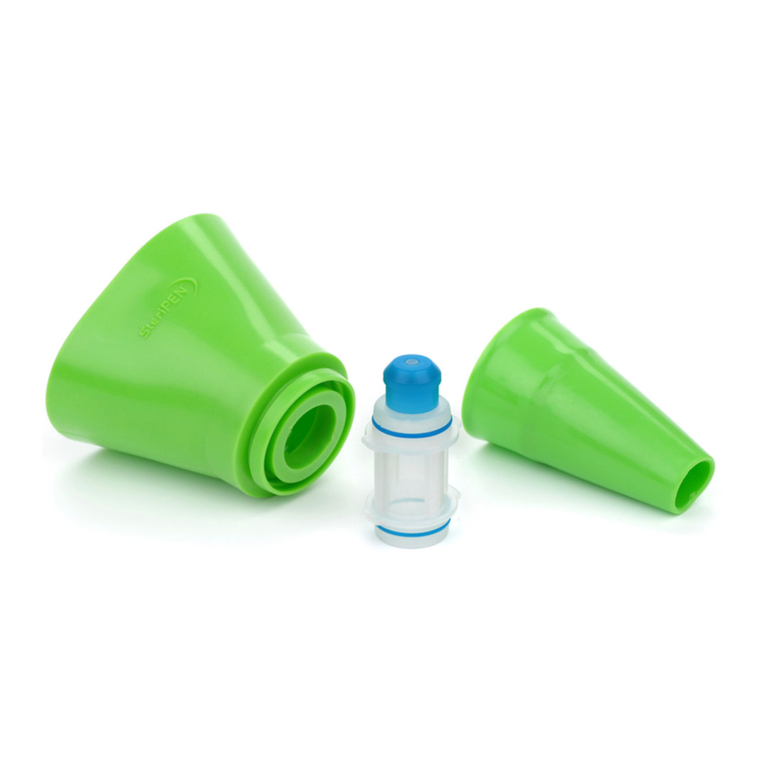
SteriPEN
SteriPEN FitsAll Filter user manual
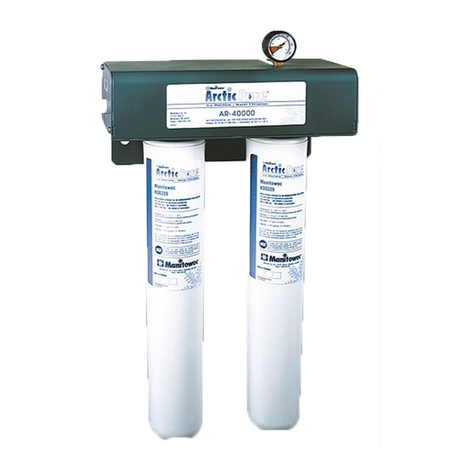
Manitowoc
Manitowoc ArcticPure AR-10000 Installation, operation and maintenance manual

Pentair
Pentair EVERPURE ENDURANCE EV943730 Installation, operation, maintenance guide
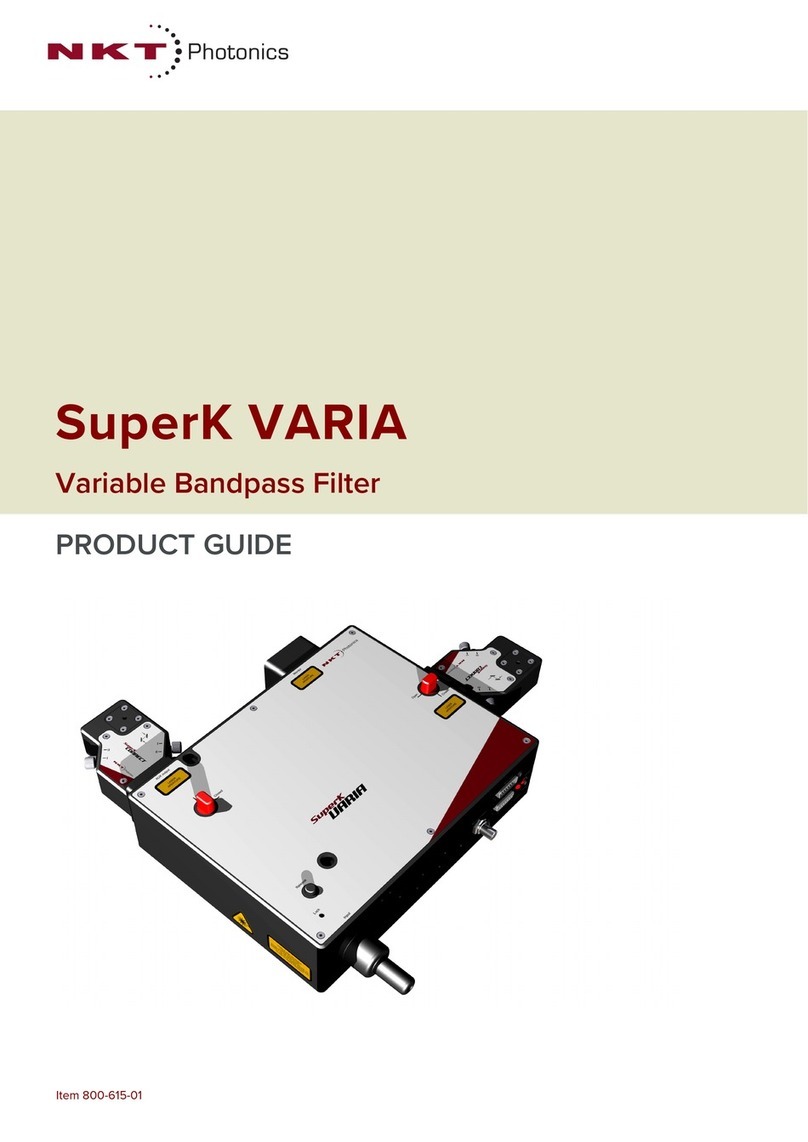
NKT Photonics
NKT Photonics SuperK VARIA Product guide
